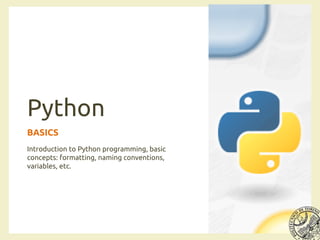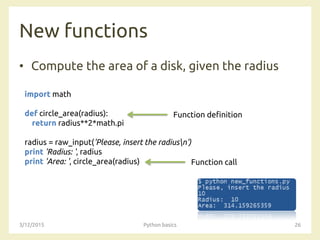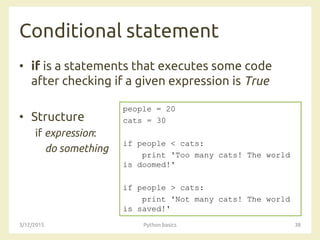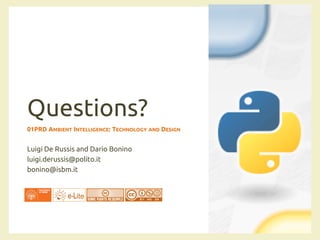The document provides an introduction to Python programming, covering essential concepts such as syntax, formatting, variables, data types, operations, loops, and control flow. It explains how to write and format Python code, use functions and modules, and handle user input and file operations. Additionally, it discusses variable naming conventions and includes examples to help illustrate these programming basics.































![Reading files
• Read a file taking its name from command line
3/12/2015 Python basics 32
from sys import argv
filename = argv[1]
txt = open(filename)
print “Here’s your file %r:", % filename
print txt.read()
print “nType the filename again:”
file_again = raw_input(“> ”)
txt_again = open(file_again)
print txt_again.read()
Open the file
Show the file content](https://image.slidesharecdn.com/04-python-basics-150316090919-conversion-gate01/85/AmI-2015-Python-basics-32-320.jpg)







![Loops and lists
• Loop
– An easy way to do repetitive things
– A condition to start and stop the loop is required
– e.g., for and while loops
• List
– A datatype for storing multiple items
• a sequence of values
– You can assign items to a list in this way:
list_name = [item1, item2, …]
3/12/2015 Python basics 40](https://image.slidesharecdn.com/04-python-basics-150316090919-conversion-gate01/85/AmI-2015-Python-basics-40-320.jpg)
![Loops and lists: an example
3/12/2015 Python basics 41
the_count = [1, 2, 3, 4, 5]
fruits = ['apples', 'oranges', 'pears', 'apricots']
change = [1, 'pennies', 2, 'dimes', 3, 'quarters']
# this first kind of for-loop goes through a list
for number in the_count:
print 'This is count %d' % number
# same as above
for fruit in fruits:
print 'A fruit of type: %s' % fruit
# we can go through mixed lists too
# notice that we have to use %r since we don't know what's in it
for i in change:
print 'I got %r' % i
Three lists](https://image.slidesharecdn.com/04-python-basics-150316090919-conversion-gate01/85/AmI-2015-Python-basics-41-320.jpg)
![Loops and lists: an example
3/12/2015 Python basics 42
the_count = [1, 2, 3, 4, 5]
fruits = ['apples', 'oranges', 'pears', 'apricots']
change = [1, 'pennies', 2, 'dimes', 3, 'quarters']
# this first kind of for-loop goes through a list
for number in the_count:
print 'This is count %d' % number
# same as above
for fruit in fruits:
print 'A fruit of type: %s' % fruit
# we can go through mixed lists too
# notice that we have to use %r since we don't know what's in it
for i in change:
print 'I got %r' % i
Structure of a for loop
• for variable in collection:
• indent for the loop body](https://image.slidesharecdn.com/04-python-basics-150316090919-conversion-gate01/85/AmI-2015-Python-basics-42-320.jpg)
![More “for”
3/12/2015 Python basics 43
# we can also build lists: start with an empty one…
elements = []
# then use the range function to do 0 to 5 counts
for i in range(0, 6):
print 'Adding %d to the list.' % i
# append() is a function that lists understand
elements.append(i)
# now we can print them out
for i in elements:
print 'Element was: %d' % i
Empty list
Repeat 6 times](https://image.slidesharecdn.com/04-python-basics-150316090919-conversion-gate01/85/AmI-2015-Python-basics-43-320.jpg)
![Lists
• Mutable
• Do not have a fixed length
– You can add items to a list at any time
• Accessible by index
3/12/2015 Python basics 44
letters = [‘a’, ‘b’, ‘c’]
letters.append(‘d’)
print letters # a, b, c, d
print letters[0] # a
print len(letters) # 4
letters[3] = ‘e’
print letters # a, b, c, e](https://image.slidesharecdn.com/04-python-basics-150316090919-conversion-gate01/85/AmI-2015-Python-basics-44-320.jpg)
![More lists
• List concatenation
– with the + operator
• List slices
– to access a portion of a list
– with the [:] operator
3/12/2015 Python basics 45
a = [1, 2, 3]
b = [4, 5, 6]
c = a + b
print c # 1, 2, 3, 4, 5, 6
c = [1, 2, 3, 4, 5, 6]
d = c[1:3] # d is [2, 3]
e = c[:3] # e is [1, 2, 3]
f = c[:] # f is a full copy of c](https://image.slidesharecdn.com/04-python-basics-150316090919-conversion-gate01/85/AmI-2015-Python-basics-45-320.jpg)
![More lists
• List concatenation
– with the + operator
• List slices
– to access a portion of a list
– with the [:] operator
3/12/2015 Python basics 46
a = [1, 2, 3]
b = [4, 5, 6]
c = a + b
print c # 1, 2, 3, 4, 5, 6
c = [1, 2, 3, 4, 5, 6]
d = c[1:3] # d is [2, 3]
e = c[:3] # e is [1, 2, 3]
f = c[:] # f is a full copy of c
works with string, too](https://image.slidesharecdn.com/04-python-basics-150316090919-conversion-gate01/85/AmI-2015-Python-basics-46-320.jpg)

![Deleting elements from a list
• Several ways to delete elements from a list
• If you know the index of the element to
remove: pop()
– without providing an index, pop() delete the last
element
• If you know the element to remove (but not the
index): remove()
• To remove more than one element: del()
– with a slice index
• e.g., del my_list[5:8]
3/12/2015 Python basics 48](https://image.slidesharecdn.com/04-python-basics-150316090919-conversion-gate01/85/AmI-2015-Python-basics-48-320.jpg)

![Copying lists
• What happens here?
3/12/2015 Python basics 50
fruits = ['apple', 'orange', 'pear', 'apricot']
print 'The fruits are:', fruits
favourite_fruits = fruits
print 'My favourite fruits are', favourite_fruits
# add a fruit to the original list
fruits.append(‘banana’)
print 'The fruits now are:', fruits
print 'My favourite fruits are', favourite_fruits](https://image.slidesharecdn.com/04-python-basics-150316090919-conversion-gate01/85/AmI-2015-Python-basics-50-320.jpg)
![Copying lists
• What happens here?
3/12/2015 Python basics 51
fruits = ['apple', 'orange', 'pear', 'apricot']
print 'The fruits are:', fruits
favourite_fruits = fruits
print 'My favourite fruits are', favourite_fruits
# add a fruit to the original list
fruits.append(‘banana’)
print 'The fruits now are:', fruits
print 'My favourite fruits are', favourite_fruits
We do not make a copy of
the entire list, but we only
make a reference to it!](https://image.slidesharecdn.com/04-python-basics-150316090919-conversion-gate01/85/AmI-2015-Python-basics-51-320.jpg)
![Copying lists
• How to make a full copy of a list?
• Various methods exist
– you can entirely slice a list
• favourite_fruits = fruits[:]
– you can create a new list from the existing one
• favourite_fruits = list(fruit)
– you can extend an empty list with the existing one
• favourite_fruits.extend(fruit)
• Prefer the list() method, when possible!
3/12/2015 Python basics 52](https://image.slidesharecdn.com/04-python-basics-150316090919-conversion-gate01/85/AmI-2015-Python-basics-52-320.jpg)

![Dictionaries: an example
3/12/2015 Python basics 54
# create a mapping of U.S. state to abbreviation
states = {
'Oregon' : 'OR',
'Florida' : 'FL',
'California' : 'CA'
}
print 'States:', states
print 'Is Oregon available?', 'Oregon' in states
# add some more states
states['New York'] = 'NY'
states['Michigan'] = 'MI'
# print two states
print "New York’s abbreviation is: ", states[‘New York’]
print "Florida’s abbreviation is: ", states[‘Florida’]
Create a dictionary with 3 key-value pairs
Add two more key-value pairs](https://image.slidesharecdn.com/04-python-basics-150316090919-conversion-gate01/85/AmI-2015-Python-basics-54-320.jpg)

![Dictionary functions
• len()
– dictionary length: the number of key-value pairs
• del()
– remove a key-value pair
• e.g., del my_dict[my_key]
• clear()
– remove all items from a dictionary
• keys() and values()
– return a copy of the dictionary’s list of key and value,
respectively
3/12/2015 Python basics 56](https://image.slidesharecdn.com/04-python-basics-150316090919-conversion-gate01/85/AmI-2015-Python-basics-56-320.jpg)


